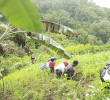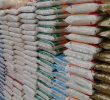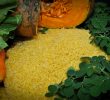
Incoming Agriculture Secretary Emmanuel Piñol during Monday’s Kapehan sa Dabaw. (Contributed photo)
DAVAO CITY — Incoming Agriculture Secretary Emmanuel Piñol demanded the local government to guarantee sufficiency of rice supply to ensure food production, and welfare of local farmers and other producers.
During Monday’s Kapehan sa Dabaw, Piñol said that “the average production in a 15 metric ton of hectare per harvest in many areas all over the country is only three tons.”
He added that we were not able to exploit the soil and agriculture to increase the productivity and to improve the conditions of our local farmers.
“My strategy is to hold the regional directors accountable. I will give them the support they need—irrigation, good seeds, fertilizer— but I will tell them ‘make your region rice sufficient, or else I will kick you out’,” he said.
Piñol showed his eagerness to solve food scarcity by demanding those “already rice sufficient regions” to increase their production by at least one metric ton.
He said that the food production strategy of Department of Agriculture (DA) will be coupled with anti-poverty programs.
Lack of water management
Meanwhile, Piñol said the country’s agricultural problem is worsened by the lack of water management.
“We are one of the many few countries in the world with a rainy season extending up to six months, floods, typhoons, but after three months of dry spell we cry water,” he said.
Piñol said he asked recently for help from the mayor of Salinas, California in searching for a hydrologist to study the water management here in the country.
“When I was in the US, I talked to the mayor of Salinas, California which is one of the leading agricultural companies in US, and I asked for his help to find for me a very good hydrologist, someone who could study water management,” he said.
Piñol said that a thorough review of Philippine agriculture is needed.
“There is a saying in agriculture, food grows, where water flows.“
Prioritizing 10 of the poorest provinces
Piñol also introduced a program called Special Area for Agricultural Development (SAAD) which intends to uplift the 10 poorest provinces in the country.
“We are identifying 10 of the poorest provinces in the country, and we will establish a project management office in collaboration with the local government office or unit,” he said.
As of 2010, Lanao del Sur is number one in the top ten poorest provinces in the Philippines, with a poverty incidence of 67.3 percent.
Eastern Samar has a poverty incidence of 55.4 percent, Apayao has 54.7 percent, Maguindanao has 54.5 percent, Zamboanga del Norte has 48 percent, Saranggani has 46 percent, North Cotabato has 44.8 percent, Negros Oriental has 43.9 percent, Northern Samar has 43.5 percent, and Western Samar has 43.5 percent. All three Samar provinces in the island belong to the poorest provinces.
Piñol said the DA will focus in increasing food production in those areas.
He said that they will look into the weaknesses and potentials of these provinces. The department will also focus their interventions in the areas of agriculture, food production and fisheries.
“By making them productive, by making them stakeholders of the food production program, we will be able to lift up their living conditions and we will be able to reduce poverty,” he said.
By the end of the Duterte administration, the DA is hoping to improve the situation of 60 of the poorest provinces in the Philippines. (davaotoday.com)










